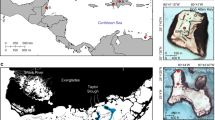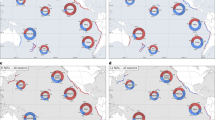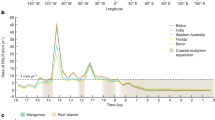Abstract
Although rising global sea levels will affect the shape of coastlines over the coming decades1,2, the most severe and catastrophic shoreline changes occur as a consequence of local and regional-scale processes. Changes in sediment supply3 and deltaic subsidence4,5, both natural or anthropogenic, and the occurrences of tropical cyclones4,5 and tsunamis6 have been shown to be the leading controls on coastal erosion. Here, we use satellite images of South American mangrove-colonized mud banks collected over the past twenty years to reconstruct changes in the extent of the shoreline between the Amazon and Orinoco rivers. The observed timing of the redistribution of sediment and migration of the mud banks along the 1,500 km muddy coast suggests the dominant control of ocean forcing by the 18.6 year nodal tidal cycle7. Other factors affecting sea level such as global warming or El Niño and La Niña events show only secondary influences on the recorded changes. In the coming decade, the 18.6 year cycle will result in an increase of mean high water levels of 6 cm along the coast of French Guiana, which will lead to a 90 m shoreline retreat.
This is a preview of subscription content, access via your institution
Access options
Subscribe to this journal
Receive 12 print issues and online access
$259.00 per year
only $21.58 per issue
Buy this article
- Purchase on Springer Link
- Instant access to full article PDF
Prices may be subject to local taxes which are calculated during checkout



Similar content being viewed by others
References
Pilkey, O. H. & Cooper, J. A. G. Society and sea level rise. Science 303, 1781–1782 (2004).
Zhang, K. Q., Douglas, B. C. & Leatherman, S. P. Global warming and coastal erosion. Clim. Change 64, 41–58 (2004).
Syvitski, J. P. M., Vorosmarty, C. J., Kettner, A. J. & Green, P. Impact of humans on the flux of terrestrial sediment to the global coastal ocean. Science 308, 376–380 (2005).
Dixon, T. H. et al. Subsidence and flooding in New Orleans. Nature 441, 587–588 (2006).
Ericson, J. P., Vorosmarty, C. J., Dingman, S. L., Ward, L. G. & Meybeck, M. Effective sea-level rise and deltas: Causes of change and human dimension implications. Glob. Planet. Change 50, 63–82 (2006).
Borrero, J. C. Field data and satellite imagery of tsunami effects in Banda Aceh. Science 308, 1596 (2005).
Wells, J. T. & Coleman, J. M. Periodic mudflat progradation, northeastern coast of South America; a hypothesis. J. Sedim. Petrol. 51, 1069–1075 (1981).
Pugh, D. T. Tides, Surges and Mean Sea-Level (Wiley, Chichester, 1987).
Marchuk, G. I. & Kagan, B. A. Dynamics of Ocean Tides (Kluwer, Dordrecht, 1989).
Eisma, D., Augustinus, P. & Alexander, C. Recent and subrecent changes in the dispersal of Amazon mud. Neth. J. Sea Res. 28, 181–192 (1991).
Meade, R. H., Dunne, T., Richey, J. E., Santos, U. M. & Salati, E. Storage and remobilisation of suspended sediment in the lower Amazon River of Brazil. Science 228, 488–490 (1985).
Baltzer, F., Allison, M. & Fromard, F. Material exchange between the continental shelf and mangrove-fringed coasts with special reference to the Amazon–Guianas coast. Mar. Geol. 208, 115–126 (2004).
Blasco, F., Saenger, P. & Janodet, E. Mangroves as indicators of coastal change. Catena 27, 167–178 (1996).
Allison, M. A. & Lee, M. T. Sediment exchange between Amazon mudbanks and shore-fringing mangroves in French Guiana. Mar. Geol. 208, 169–190 (2004).
Gardel, A. & Gratiot, N. A satellite image-based method for estimating rates of mud bank migration, French Guiana, South America. J. Coast. Res. 21, 720–728 (2005).
Lefebvre, J. P., Dolique, F. & Gratiot, N. Geomorphic evolution of a coastal mudflat under oceanic influences: an example from the dynamic shoreline of French Guiana. Mar. Geol. 208, 191–205 (2004).
Fromard, F., Vega, C. & Proisy, C. Half a century of dynamic coastal change affecting mangrove shorelines of French Guiana. A case study based on remote sensing data analyses and field surveys. Mar. Geol. 208, 265–280 (2004).
Plaziat, J. C. & Augustinus, P. Evolution of progradation/erosion along the French Guiana mangrove coast: A comparison of mapped shorelines since the 18th century with Holocene data. Mar. Geol. 208, 127–143 (2004).
Augustinus, P. G. E. F. The Changing Shoreline of Surinam (South America). Thesis, Univ. Utrecht (1978).
Choubert, B. & Boyé, M. Envasements et désenvasements du littoral en Guyane française. C. R. Acad. Sci. 249, 145–147 (1959).
Kineke, G. C. Fluid Muds on the Amazon Continental Shelf. Thesis, Univ. Washington, Seattle (1993).
Gibbs, R. J. Amazon River sediment transport in Atlantic Ocean. Geology 4, 45–48 (1976).
Guyot, J. L., Filizola, N. & Laraque, A. Sediment Budgets 347–356 (IAHS Publ. 291, IAHS, Iguacu, 2005).
Allison, M. A., Lee, M. T., Ogston, A. S. & Aller, R. C. Origin of Amazon mudbanks along the northeastern coast of South America. Mar. Geol. 163, 241–256 (2000).
Gaucherel, C. A study of the possible extended influence of the ENSO phenomenon. Comptes Rendus Geosci. 336, 175–185 (2004).
Hammond, D. S. & ter Steege, H. Propensity for fire in Guianan rainforests. Conservation Biol. 12, 944–947 (1998).
Mol, J. H., Resida, D., Ramlal, J. S. & Becker, C. R. Effects of El Nino-related drought on freshwater and brackish-water fishes in Suriname, South America. Environ. Biol. Fish. 59, 429–440 (2000).
Anthony, E. J., Gardel, A., Dolique, F. & Guiral, D. Short-term changes in the plan shape of a sandy beach in response to sheltering by a nearshore mud bank, Cayenne, French Guiana. Earth Surf. Process. Land. 27, 857–866 (2002).
Simon, B. La Marée Océanique Côtière (Institut Océanographique, Paris, 2007).
Acknowledgements
We wish to thank M. Nourtier, B. Simon and J. L. Guyot. This work has the financial support of the Programme National Environnement Côtier, of the Research Council of the Université du Littoral Côte d’Opale and of the Centre National des Etudes Spatiales and the Ecolab Association. Sea-level fluctuations were extracted from http://las.aviso.oceanobs.com/las/servlets/dataset merged product. ASAR/ENVISAT data are provided by ESA 2006, source SEAS-Guyane.
Author information
Authors and Affiliations
Contributions
N.G. led the project on the basis of a hypothesis initially proposed by J.T.W; N.G., A.G., C.P., E.J.A. and N.G. analysed the remote sensing data and the shoreline dynamics; C.G. provided insights concerning regional El Niño and La Niña dynamics; N.G., E.J.A. & J.T.W. wrote the paper.
Corresponding author
Supplementary information
Supplementary Information
Supplementary Figures S1-3 and table S1 (PDF 688 kb)
Rights and permissions
About this article
Cite this article
Gratiot, N., Anthony, E., Gardel, A. et al. Significant contribution of the 18.6 year tidal cycle to regional coastal changes. Nature Geosci 1, 169–172 (2008). https://doi.org/10.1038/ngeo127
Received:
Accepted:
Published:
Issue Date:
DOI: https://doi.org/10.1038/ngeo127
This article is cited by
-
Study on shoreline migration and island dynamics over the last five decades in the Muriganga River using multi-temporal satellite images
Environmental Monitoring and Assessment (2024)
-
Large-Scale Channel Migration in the Sittang River Estuary
Scientific Reports (2019)
-
Flood Hazard Assessment for a Hyper-Tidal Estuary as a Function of Tide-Surge-Morphology Interaction
Estuaries and Coasts (2018)
-
Influence of a Drought Event on Hydrological Characteristics of a Small Estuary on the Amazon Mangrove Coast
Estuaries and Coasts (2018)
-
New evidence of Yangtze delta recession after closing of the Three Gorges Dam
Scientific Reports (2017)



